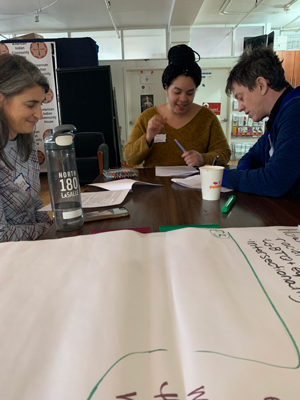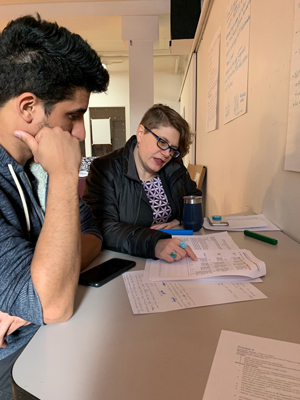Research Projects
Dr. Levandowski's work falls under three main headings:
- Reproductive and Sexual Health
- Stigmatized Populations
- Social Determinants of Health
Reproductive and Sexual Health
Improving contraceptive conversations between young women and their providers: A community based participatory research project
This project conducted fourteen focus groups with young women and providers to determine ways to improve patient-provider communication concerning contraception decisions, generating baseline data of the types of patient and provider interventions necessary to generate a shared decision making encounter. This project included a Community Advisory Board that met 10 times to review qualitative questionnaires, review and interpret data, and decide next steps.
Collaborators: SUNY Upstate Medical University, REACH CNY's Comprehensive Adolescent Pregnancy Prevention Community Advisory Council
Measuring postpartum contraceptive uptake and interconception periods in the electronic medical record
This project tested the proof of concept to create an automated electronic medical record module for University of Rochester Medical Center (URMC) and SUNY Upstate Health Care Center (UHCC) Obstetrics/Gynecology providers to measure their impact on postpartum contraceptive uptake and birth spacing in their patient population, for use in clinical care. This project extracted data from the electronic medical records (EMR) of women giving birth at Strong Memorial Hospital in Rochester, NY and Crouse Hospital in Syracuse, NY to determine if birth spacing is related to postpartum contraceptive use. The project used natural language processing to extract data from EMR notes.
Collaborators: SUNY Upstate Medical University; University of Rochester Department of Computer Science
Estimating the impact of unsafe abortion on maternal morbidity and mortality on the African Continent
While at Ipas I managed the Consortium for Research on Unsafe Abortion which focused on: 1. improved understanding of the prevalence, causes and consequences of unwanted pregnancy and unsafe abortion; 2. providing evidence to support actions to reduce unwanted pregnancy and unsafe abortion; and 3. increasing women’s access to high quality, comprehensive, safe abortion care, within the limits of the law, and post-abortion care.
In collaboration with Ministries of Health and other country-based organizations, projects included:
- Estimating the incidence of abortion and magnitude of complications due to unsafe abortion in Malawi
- Estimating the incidence of abortion and magnitude of complications due to unsafe abortion in Kenya
- Evaluation of an intervention with the Uganda Private Midwives Association in Uganda
Collaborators: Ipas, African Population and Health Research Center, Ethiopian Society of Obstetricians & Gynecologists, Guttmacher Institute
Stigmatized Populations
LGBTQ+ Health Initiative: Statewide Multicultural & Culturally Responsive Organizational Development

This five year project supports 37 NYS health and human service agencies in reducing disparities experienced by LGBTQ+ populations by supporting care provision within the context of cultural humility and supporting organizations in their efforts towards advancing organizational-level LGBTQ+ and racial equity. This project is informed by a Community Advisory Board of 17 LGBTQ+ Rochestarians with a variety of experiences.
Collaborators: Timothy Dye, Monica Barbosu, John Cullen, Scott Fearing, New York State Department of Health AIDS Institute



Veterans at risk of suicide
This project investigated team-based processes in primary care, focused around what can be learned from suicide prevention efforts in the Veterans Health Administration. Using qualitative methods, we surveyed primary care health providers to determine how collaborative care processes facilitated and hindered suicide prevention efforts.
Collaborators: Veterans Health Administration Center of Excellence for Suicide Prevention, Injury Control Research Center for Suicide Prevention
Social Determinants of Health
Maternal and infant health outcomes in Syracuse, NY
This collection of studies utilized social epidemiological methodologies to explore various elements of structural violence that contribute to racial and ethnic disparities in maternal and infant health outcomes in Syracuse, NY. Two studies evaluated, Syracuse Healthy Start (SHS), an HRSA-funded initiative designed to reduce racial and ethnic disparities in birth outcomes. Three additional projects investigated societal factors that contribute to poor maternal and infant health outcomes. We found that the high proportion of African American men who cycle through jail and prison in this community has led to a skewed sex ratio, impacting African American women’s ability to have control over their sexual relationships and reproductive health. A structured observational analysis found that pregnant women living in proximity to a supermarket had significantly fewer low birth weight births than other pregnant women regardless of income level. Lastly, mothers’ childhood lead exposure was associated with repeat teen pregnancy and tobacco use, after controlling for race, age, and Medicaid status.
Collaborators: Sandra D. Lane and Robert Rubenstein at Syracuse University
HIV prevention behaviors
Within Romania
Romanian HIV/AIDS clinical providers were asked about current and emerging training in HIV/AIDS content areas, and background information on screening and treatment practices. Clinicians indicated a variety of social, cultural and organizational reasons to not test for HIV, and were very interested in training on prevention and treatment of occupational exposure and pre- and post-exposure prophylaxis. Clinicians requested online and in person training and were daily users of social media platforms, most specifically Facebook and WhatsApp.
Collaborators: Timothy Dye, Monica Barbosu, Amanda Radulescu, Carmen Manciuc
Among African youth
This collection of studies used the proximate determinants model to investigate the role of underlying and proximate determinants in contributing to gender disparities in HIV infection among South African youth. Multivariate analyses of a weighted nationally representative survey of South African youth aged 15-24 years was conducted to elucidate the role of transmission efficiency education level, consistent condom use and sexually risky behavior in this disparity.
Collaborators: Audrey Pettifor and Myron Cohen at UNC-Chapel Hill
Among individuals in the United States
These studies identified contributing factors to STI and HIV prevention efforts in the United States. Two studies were focused on HIV prevention, determining the association between high density HIV prevention networks and lower syphilis rates, and identifying gaps in HIV prevention services. Three studies focused on STIs of gonorrhea, Chlamydia, genital herpes and hepatitis A/B. Census tract incarceration rates were consistently associated with gonorrhea rates, but not Chlamydia rates, in the subsequent year. Two nationally representative, weighted longitudinal datasets of American youth found associations between gonorrhea testing and a history of HIV testing and other STI diagnoses among college age students. Lastly, men whose health care provider recommended hepatitis vaccination were 12.9 (95%CI 8.1-20.6) times as likely to be vaccinated against hepatitis A and 17.9 (95%CI 10.8-29.7) times as likely to be vaccinated against hepatitis B than those at risk of infection.
Collaborators: James Thomas, Elizabeth Torrone, Lisa Gilbert